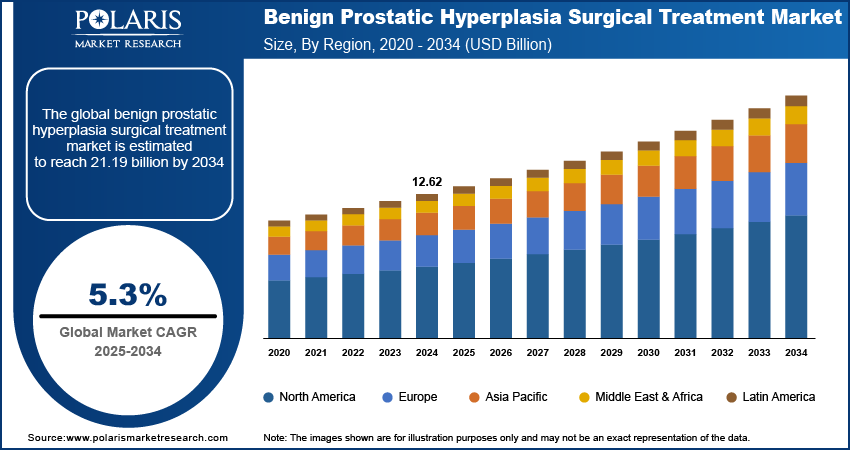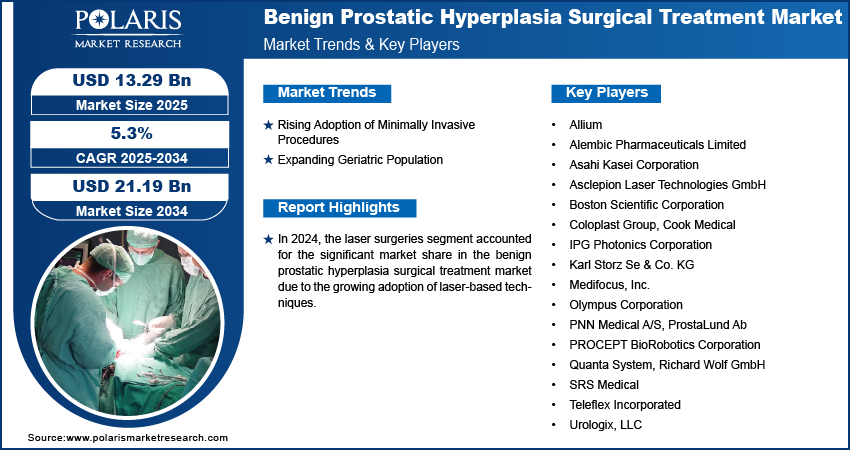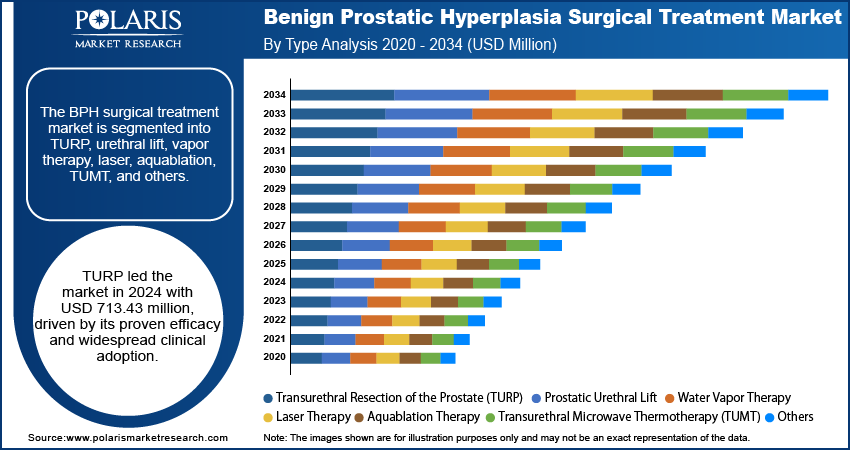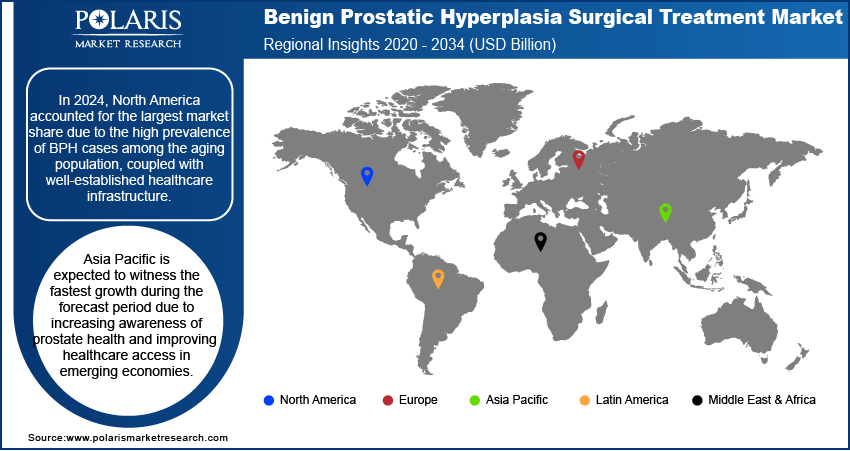
Benign Prostatic Hyperplasia Surgical Treatment Market Size, Share, Trends, Industry Analysis Report: By Type, End User (Hospitals, Ambulatory Surgery Centers and Clinics, and Homecare Settings), and Region (North America, Europe, Asia Pacific, Latin America, and Middle East & Africa) – Market Forecast, 2025–2034
- Published Date:Apr-2025
- Pages: 129
- Format: PDF
- Report ID: PM5490
- Base Year: 2024
- Historical Data: 2020-2023
Benign Prostatic Hyperplasia Surgical Treatment Market Overview
The global benign prostatic hyperplasia surgical treatment market size was valued at USD 12.62 billion in 2024. The market is expected to grow from USD 13.29 billion in 2025 to USD 21.19 billion by 2034, exhibiting a CAGR of 5.3% from 2025 to 2034.
The benign prostatic hyperplasia (BPH) surgical treatment market focuses on medical procedures and devices used to treat BPH, a non-cancerous enlargement of the prostate gland. These treatments offer minimally invasive and surgical solutions to alleviate urinary symptoms and improve quality of life.
The rising incidence of benign prostatic hyperplasia, particularly among the aging male population, is driving the demand for surgical treatments to manage severe cases. In addition, technological innovations, such as laser-based procedures (e.g., HoLEP and GreenLight) and minimally invasive surgeries, are enhancing treatment efficacy and patient outcomes, further boosting the benign prostatic hyperplasia surgical treatment market growth.

To Understand More About this Research: Request a Free Sample Report
Expanding healthcare infrastructure and greater access to advanced treatment options in emerging markets are driving the benign prostatic hyperplasia surgical treatment market demand. Furthermore, enhanced awareness campaigns and improved diagnostic tools are leading to early detection of BPH, driving the need for effective surgical interventions.
Benign Prostatic Hyperplasia Surgical Treatment Market Dynamics
Rising Adoption of Minimally Invasive Procedures
The rising adoption of minimally invasive surgeries is significantly contributing to the benign prostatic hyperplasia surgical treatment market development. These techniques, including laser therapies and transurethral microwave procedures, are being increasingly preferred for their faster recovery, reduced hospital stays, and minimal post-operative complications. This preference is prompting both patients and healthcare providers to opt for procedures that deliver improved clinical outcomes and enhanced patient satisfaction. Furthermore, advancements in technology are expanding the range of minimally invasive options. For instance, in February 2024, Philips launched the Azurion neuro biplane system, aimed at improving the speed and accuracy of minimally invasive procedures for neurovascular patients through advanced imaging technology. The shift towards these innovative solutions is driving adoption, particularly as outpatient settings increasingly embrace efficient and cost-effective treatment methods.
Expanding Geriatric Population
The expanding geriatric population is another key factor contributing to the benign prostatic hyperplasia surgical treatment market revenue. For instance, according to the World Health Organization, the proportion of individuals aged 60 and above is projected to rise from 12% to 22% of the global population between 2015 and 2050. As the aging population increases, so does the prevalence of prostate-related issues like BPH, creating significant demand for effective surgical solutions. Older individuals are more susceptible to urinary and prostate complications, fueling the need for advanced treatments that improve quality of life. This demographic shift is prompting healthcare providers to focus on addressing the unique needs of this population. Additionally, growing life expectancy has amplified demand, as it increases the pool of patients requiring surgical interventions for BPH.

Benign Prostatic Hyperplasia Surgical Treatment Market Segment Insights
Benign Prostatic Hyperplasia Surgical Treatment Market Assessment by Type Outlook
The global benign prostatic hyperplasia surgical treatment market segmentation, based on type, includes transurethral resection of the prostate (TURP), laser surgeries, urolift procedures, rezum procedures, robot-assisted waterjet ablation, prostatic stents, transurethral microwave thermotherapy (TUMT), transurethral needle ablation of the prostate (TUNA), prostatic arterial embolization (PAE), and other procedures. In 2024, the laser surgeries segment accounted for a significant market share due to the growing adoption of laser-based techniques like Holmium Laser Enucleation of the Prostate (HoLEP) and GreenLight Laser Therapy. These procedures are favored for their precision, reduced risk of bleeding, and ability to treat larger prostates with fewer complications. Additionally, advancements in laser technology have enhanced procedural efficacy, reducing recovery time and hospital stays. The increasing availability of specialized urology centers equipped with state-of-the-art laser systems has further amplified market demand, solidifying the segment's dominance in the BPH surgical treatment landscape.
Benign Prostatic Hyperplasia Surgical Treatment Market Evaluation by End User Outlook
The global benign prostatic hyperplasia surgical treatment market segmentation, based on end user, includes hospitals, ambulatory surgery centers and clinics, and homecare settings. In 2024, the homecare settings segment accounted for the largest market share due to the rising demand for post-surgical care solutions that provide convenience and cost efficiency. With the growing prevalence of minimally invasive procedures, patients increasingly require home-based recovery support, such as catheter management and telehealth monitoring. The growth of home healthcare services, coupled with technological advancements in portable medical devices for BPH management, has further fueled this segment's expansion. Additionally, shifting patient preferences toward homecare settings for faster recovery and reduced hospital expenses have played a pivotal role in driving the segment’s leading position, highlighting its significance in the broader BPH treatment ecosystem.

Benign Prostatic Hyperplasia Surgical Treatment Market Regional Analysis
By region, the study provides the benign prostatic hyperplasia surgical treatment market market insights into North America, Europe, Asia Pacific, Latin America, and the Middle East & Africa. In 2024, North America held the largest share of the global market due to the high prevalence of BPH cases among the aging population, coupled with a well-established healthcare infrastructure. The widespread availability of advanced surgical technologies, such as laser-based treatments and robotic-assisted surgeries, has further contributed to the regional market dominance. For instance, according to NCBI, in 2024, an estimated 4,040.6 million patients underwent emergency general surgery, with 65.9 million (1.6%) procedures being performed using robotic techniques in the US. The proportion of robotic-assisted minimally invasive surgeries in emergency general surgery has significantly increased over time. Moreover, substantial healthcare expenditure and the presence of leading market players in the region contribute to the rapid adoption of innovative procedures. Favorable reimbursement policies for surgical interventions also drive demand for these treatments, enabling wider patient access to these treatments and ensuring consistent expansion of the regional market.
The Asia Pacific benign prostatic hyperplasia surgical treatment market is expected to witness the fastest growth during the forecast period due to increasing awareness of prostate health and improving healthcare access in emerging economies. Rapid advancements in medical infrastructure, particularly in countries like China and India, are enabling the adoption of advanced surgical techniques. Additionally, the region's expanding geriatric population, coupled with rising disposable income, has led to higher demand for effective BPH treatments. For instance, according to the Asian Development Bank, around 25% of the population in Asia and the Pacific will be aged 60 and older by 2050, a group that is projected to triple from 2010 levels, reaching nearly 1.3 billion individuals. Moreover, growing medical tourism in the region, driven by cost-effective yet high-quality surgical options, is contributing to the regional market’s robust growth trajectory.

Benign Prostatic Hyperplasia Surgical Treatment Market – Key Players and Competitive Insights
The competitive landscape of the benign prostatic hyperplasia surgical treatment market is characterized by the presence of several key players focused on innovation and technological advancements. Leading companies are heavily investing in research and development to introduce minimally invasive and laser-based surgical techniques, such as HoLEP and GreenLight Laser Therapy, which offer improved patient outcomes and reduced recovery times. Strategic collaborations and mergers and acquisitions are common strategies employed by market participants to strengthen their product portfolios and expand their geographic presence. The market also sees intense competition driven by the demand for cost-effective solutions, with emerging players introducing advanced devices tailored for outpatient and homecare settings. Additionally, the adoption of robotic-assisted surgeries and AI-powered diagnostic tools is shaping the benign prostatic hyperplasia surgical treatment market competitive dynamics as players strive to differentiate their offerings in an increasingly sophisticated market. Some of the key players in the market are Allium, Alembic Pharmaceuticals Limited, Asahi Kasei Corporation, Asclepion Laser Technologies GmbH, Boston Scientific Corporation, Coloplast Group, Cook Medical, IPG Photonics Corporation, Karl Storz Se & Co. KG, Medifocus, Inc., Olympus Corporation, PNN Medical A/S, ProstaLund Ab, PROCEPT BioRobotics Corporation, Quanta System, Richard Wolf GmbH, SRS Medical, Teleflex Incorporated, Urologix, LLC.
Asahi Kasei Corporation, founded in 1931, is a Japanese chemical company headquartered in Tokyo. The company operates across various sectors, such as chemicals, healthcare, and construction materials, with a focus on innovation and sustainability. In the healthcare sector, Asahi Kasei is actively involved in developing BPH solutions. The company produces medical devices and pharmaceuticals aimed at improving patient outcomes in urology. Their portfolio includes advanced technologies for blood purification and filtration, which is crucial in managing complications associated with BPH treatments. Asahi Kasei's commitment to improving healthcare extends to its acquisition of ZOLL Medical Corporation, which specializes in critical care devices. This strategic move has strengthened its capabilities in developing comprehensive solutions for acute care settings. The company's approach combines cutting-edge research with practical applications to address unmet medical needs. Leveraging its extensive expertise in chemical manufacturing and medical device development, Asahi Kasei continues to contribute significantly to the advancement of surgical treatments for BPH and other health challenges globally.
Boston Scientific Corporation (BSC), an American biotechnology and biomedical engineering firm founded in 1979, is a multinational manufacturer of medical devices used in various interventional medical specialties. Headquartered in Marlborough, Massachusetts, BSC has a long history of developing and marketing minimally invasive medical devices. The company's products are used in interventional radiology, cardiology, neuromodulation, neurovascular intervention, electrophysiology, cardiac and vascular surgery, endoscopy, oncology, urology, and gynecology. BSC is known for its focus on innovation, market expansion, and organizational efficiency. One area of focus for BSC is urology, with products designed to treat BPH. The company offers several surgical treatments for BPH, such as the GreenLight XPS laser therapy system, which uses laser energy to remove excess prostate tissue and the Rezūm system, a minimally invasive procedure that uses radiofrequency energy to deliver targeted water vapor ablation to reduce prostate size.
List of Key Companies in Benign Prostatic Hyperplasia Surgical Treatment Market
- Allium
- Alembic Pharmaceuticals Limited
- Asahi Kasei Corporation
- Asclepion Laser Technologies GmbH
- Boston Scientific Corporation
- Coloplast Group
- Cook Medical
- IPG Photonics Corporation
- Karl Storz Se & Co. KG
- Medifocus, Inc.
- Olympus Corporation
- PNN Medical A/S
- ProstaLund Ab
- PROCEPT BioRobotics Corporation
- Quanta System
- Richard Wolf GmbH
- SRS Medical
- Teleflex Incorporated
- Urologix, LLC
Benign Prostatic Hyperplasia Surgical Treatment Industry Developments
In January 2025, Mount Sinai Hospital became the first facility in New York City to use the HYDROS Robotic System for managing benign prostatic hyperplasia. This advanced platform employs minimally invasive techniques to enhance treatment precision and patient outcomes for those with enlarged prostates.
In December 2024, Teleflex Incorporated launched the UroLift 2 System with Advanced Tissue Control, designed to effectively treat all prostate types.
In August 2024, PROCEPT BioRobotics received FDA clearance for the HYDROS Robotic System, an AI-driven platform for aquablation therapy. Its Robotic Resection feature ensures precise waterjet execution, standardizing the surgical experience across diverse prostate anatomies.
Benign Prostatic Hyperplasia Surgical Treatment Market Segmentation
By Type Outlook (Revenue, USD Billion, 2020–2034)
- Transurethral Resection of the Prostate (TURP)
- Laser Surgeries
- Urolift Procedures
- Rezum Procedures
- Robot-Assisted Waterjet Ablation
- Prostatic Stents
- Transurethral Microwave Thermotherapy (TUMT)
- Transurethral Needle Ablation of the Prostate (TUNA)
- Prostatic Arterial Embolization (PAE)
- Other Procedures
By End User Outlook (Revenue, USD Billion, 2020–2034)
- Hospitals
- Ambulatory Surgery Centers and Clinics
- Homecare Settings
By Regional Outlook (Revenue, USD Billion, 2020–2034)
- North America
- US
- Canada
- Europe
- Germany
- France
- UK
- Italy
- Spain
- Netherlands
- Russia
- Rest of Europe
- Asia Pacific
- China
- Japan
- India
- Malaysia
- South Korea
- Indonesia
- Australia
- Vietnam
- Rest of Asia Pacific
- Middle East & Africa
- Saudi Arabia
- UAE
- Israel
- South Africa
- Rest of Middle East & Africa
- Latin America
- Mexico
- Brazil
- Argentina
- Rest of Latin America
Benign Prostatic Hyperplasia Surgical Treatment Market Report Scope
|
Report Attributes |
Details |
|
Market Size Value in 2024 |
USD 12.62 billion |
|
Market Size Value in 2025 |
USD 13.29 billion |
|
Revenue Forecast by 2034 |
USD 21.19 billion |
|
CAGR |
5.3% from 2025 to 2034 |
|
Base Year |
2024 |
|
Historical Data |
2020–2023 |
|
Forecast Period |
2025–2034 |
|
Quantitative Units |
Revenue in USD billion and CAGR from 2025 to 2034 |
|
Report Coverage |
Revenue Forecast, Market Competitive Landscape, Growth Factors, and Trends |
|
Segments Covered |
|
|
Regional Scope |
|
|
Competitive Landscape |
|
|
Report Format |
|
|
Customization |
Report customization as per your requirements with respect to countries, regions, and segmentation. |
FAQ's
The global benign prostatic hyperplasia surgical treatment market size was valued at USD 12.62 billion in 2024 and is projected to grow to USD 21.19 billion by 2034.
The global market is projected to register a CAGR of 5.3% during the forecast period.
In 2024, North America accounted for the largest market share due to the high prevalence of BPH cases among the aging population, coupled with well-established healthcare infrastructure.
Some of the key players in the market are Allium; Alembic Pharmaceuticals Limited; Asahi Kasei Corporation; Asclepion Laser Technologies GmbH; Boston Scientific Corporation; Coloplast Group; Cook Medical; IPG Photonics Corporation; Karl Storz Se & Co. KG; Medifocus, Inc.; Olympus Corporation; PNN Medical A/S; ProstaLund Ab; PROCEPT BioRobotics Corporation; Quanta System; Richard Wolf GmbH; SRS Medical; Teleflex Incorporated; and Urologix, LLC.
In 2024, the laser surgeries segment accounted for a significant market share due to the growing adoption of laser-based techniques.
The homecare settings segment accounted for the largest market share in 2024 due to the rising demand for post-surgical care solutions that provide convenience and cost efficiency.
